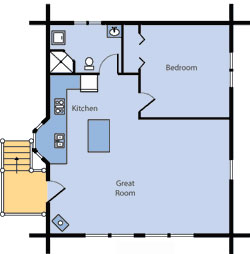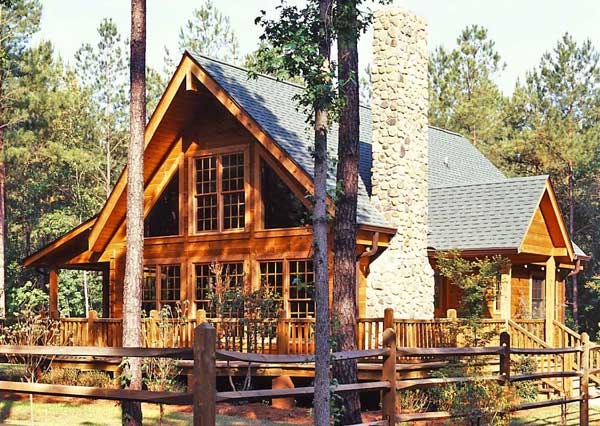Want to live large in cozy quarters? Here are 9 ways to make the most of the space in your log home.
Maybe you're trying to cut costs by cutting square footage, or perhaps your lot size limits your log home's footprint. It could be that you just like the cozy feel of a smaller home, or you prefer to put your money into exquisite details rather than sheer size. Whatever your reasons, if you're looking for ways to make the most of the space in your log home, there are plenty of clever ideas to create storage and save precious space.
1. Begin with an open floor plan

An open floor plan will help make the most of the space in your log home.
"In a small house, if two rooms open up to each other, it feels bigger than two small rooms that are separated by doors," says Gordon Hughes, staff architect for Maple Island Log Homes in Suttons Bay, Michigan. "In the homes that I design, the kitchen, dining and living areas flow pretty continuously."
To create a more subtle division between rooms without affecting flow, Jeff Visner of Conover, Wisconsin-based Design/Build by Visner Inc. recommends using varied ceiling heights or log columns to differentiate spaces. "You don't want to have all the rooms falling into one another," he says.
Lynda Tompkins of
Timberhaven Log & Timber Homes in Middleburg, Pennsylvania, suggests avoiding odd-shaped rooms. "The more you break up the space by creating nooks and crannies," she says, "the more you end up tying up valuable floor space." So the goal? Keep it simple.
2. Minimize foyers and hallways
"Hallways are a waste of space and can be awkward-looking," says Gordon, who suggests building circulation space into the rooms themselves. "For instance, in a home I'm currently working on, we're making the dining room large enough to have a table and still be able to walk around it to get to the screened-in porch, the front door or the kitchen," he says.
Consider reducing the size of your foyer. According to Jeff, a foyer that measures just 4 feet by 6 feet will suffice.
3. Shave the stairways
There are two schools of thought when it comes to designing stairways for small homes. "Stairways that are single runner and are centered in the middle of the room take up space, because they divide space and take away from the openness," says Jeff, who prefers a returning staircase with a landing. "It adds charm," he explains.
On the other hand, says Gordon, "If you really want to be efficient, avoid a landing. Straight run stairs are more efficient than L-shaped or U-shaped stairs." Whichever design you choose, situate the stairway in a corner or against an outside wall.
The same rule applies to the fireplace, which you might consider tucking into a corner, at an angle against two walls. "You want to put it along the perimeter when you're trying to maximize space," Jeff says. "When you put it in the middle of a space, it's like putting a big refrigerator in the middle of the room."
4. Eliminate the laundry room
Your washer and dryer don't need to have a room to themselves. They can be worked into a master bedroom closet (near to where laundry is actually generated), camouflaged in a bathroom behind bi-fold doors, or incorporated into a mudroom with a coat rack and outside entrance. Some units have even been designed to fit compactly into the kitchen. And don't forget about stackable units, which can save half the floor space.
5. Create dual-use rooms
In many cases, rooms can be combined to create multipurpose areas. "Rather than a dedicated guestroom, you could have a main floor office, library or small television room that services multiple purposes," Gordon says. Whatever the decor, just include a daybed or a fold-out couch to accommodate overnight guests.
6. Seek new spaces
Lynda recommends window seats with under-seat storage and Jeff likes flip-top foyer benches that hide mittens, hats and scarves. She also suggests installing a built-in cabinet in the dead space behind an open door. "As the door is perpendicular to the wall, you've got about 1 1/2 feet on the wall behind it," she says. "You never need the door open more than that."
Although these storage ideas are right under our noses, some of the best solutions are over them-literally. For instance, cathedral ceilings, common in many log homes, create a host of possibilities. "You don't need a 15-foot ceiling in the bathroom or the closet," Gordon says. "So a lot of times, we'll put in a loft above the second-story bathrooms and closets to utilize some of that extra space. You can use it for storage, or a place for kids to play." A bedroom with a cathedral ceiling can also easily accommodate bunk beds, saving valuable floor space, Gordon adds.
To get more use from overhead space, Jeff likes to add an interior "step" to a gable, forming what he calls a pot ledge. "You create these shelves where you can put your decorative objects, and add depth to a room, creating a sense of space," he says.
Lynda suggests maximizing storage under roof areas where there is low clearance. For instance, you might add a door to access under-eave attic space on either side of a gable dormer. Or, as Gordon suggests, you could install bookshelves or a television nook into the sloped recesses of a second-story loft.
7. Condense the master bath
Though today's master bathrooms often approximate the size of a football field and boast more counter space than a delicatessen, there are ways to scale back without sacrificing style or function. For instance, instead of planning a separate tub and walk-in shower, consider combining the two. Or, if you don't really care for baths, forgo the tub in favor of a solo shower stall.
"The master bathroom can still be luxurious," Gordon says, "even if you can't throw a football across the room."
8. Reduce closets
Some log home owners might consider shaving a few square feet off the master bedroom closet. "Ask yourself, 'Are we using this home once a week? Are we there two weeks in the summer? Are we there everyday?' " Gordon says. "People have wanted all their lives to have a 10-by-15-foot walk-in closet, but if you're only weekending in that house, it doesn't make sense.
"But," he adds, "a lot of people are planning this as their retirement home and plan to live their permanently, so you have to look down the road as well."

When it comes to log homes, bigger isn't necessarily better.
9. Remember, bigger isn't always better
"I think cozy is the key in many log homes," Gordon says. "It's hard to convince people that a great room that is 16 by 18 feet is sometimes more comfortable than one that's 20 by 30 feet."
There is, after all, an undeniable appeal to the feeling of snug security in a small space. "It's just a basic human instinct," Gordon says.
With these tips in mind, you're sure to create much-needed space in your log home.
